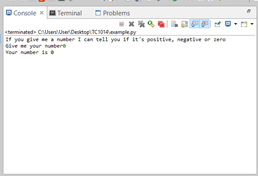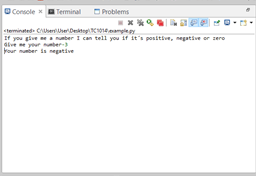A condition is an operation used in programs to see if something is true or not. These conditionals help you doing ac action whenever they are true. During this post I will guide you on how to use them properly for the creation of a program:
First of all we need to understand which ones are these conditionals.
The first one is called IF. We place it in the middle of out code to see if a condition is true or false. We can only place it once, the rest of the conditions will be evaluated by a different function.
The second one is ELIF. This one can be used to evaluate many conditions along the same IF. This function can be used as many times as you want, as long as you state the word “elif” followed by the statement you want to evalute.
ELSE is the last conditional. It is use to stablish what will happen in case none of the conditions above is true.
Now, we are creating a program that will evaluate a given number and show if it´s positive, negative or 0.
So we start by asking the user for a number.
How we start with our first condition; if the number is greater than zero, then it´s a positive number. So, for this we need to type if followed by the condition that would be x>0. At the end of the line we place a colon ( : ).
After this, we need the program to let the user know that the number is positive, se we create an output. This output need to be intended to show that is the action the computer should do in case the condition is true.
If this condition is not true, then it means that the number is zero or a negative number. To differentiate if this number is zero or negative we will need another conditional. But as we explained before, this conditional cannot be an IF conditional, but an ELIF.
An ELIF conditional works just an IF conditional: you place the word “elif” followed by the condition “x==0” and ending with a colon. Now the condition we will be evaluating is if the number is equal to zero. (It is necessary to place two equal signs to evaluate)
If none of this conditions are true, then we know that the number given by the user if not zero or greater than zero; therefore, this number is lower than zero. We know that the only numbers that are lower than zero are negative numbers.
Based on the previous reasoning, if this numbers fails to be true in both conditionals, then it is a negative number.
Now we know we don´t need to evaluate in any other condition so we can use the conditional ELSE. For this, we only write the word “else” followed by a colon. That, we just need to type the action we want the computer to do.
And this is what will happen when you run this program:
![]() If, Elif, and Else by Frida Diaz is licensed under a Creative Commons Attribution 4.0 International License.
If, Elif, and Else by Frida Diaz is licensed under a Creative Commons Attribution 4.0 International License.



